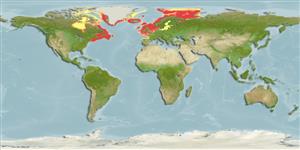Environment: milieu / climate zone / depth range / distribution range
Ekologi
marina; brackvatten bottenlevande; djupintervall 0 - 451 m (Ref. 58496). Polar; 80°N - 40°N, 95°W - 60°E
Eastern Atlantic: south-eastern coasts of Greenland, Jan Mayen Island, Iceland to British Isles and southward to Bay of Biscay, also North Sea, Baltic Sea, Spitsbergen and southern part of Barents Sea (including White Sea). Western Atlantic: James Bay in Canada to New York, USA (Ref. 7251). Arctic Ocean.
Length at first maturity / Size / Vikt / Age
Maturity: Lm 17.8, range 15 - 30 cm
Max length : 60.0 cm TL hane/ej könsbestämd; (Ref. 9925); common length : 24.0 cm SL hane/ej könsbestämd; (Ref. 4698); rapporterad maxålder: 18 år (Ref. 122394)
Taggstrålar i ryggfenan (totalt) : 7 - 11; Mjukstrålar i ryggfenan (totalt) : 13 - 19; Taggstrålar i analfenan: 0; Mjukstrålar i analfenan: 9 - 15; Ryggkotor: 34 - 39. Caudal fin rounded. Greenish brown above, often with dark blotches and bright milky-white spots above pectoral fins; underside cherry red (males) or light orange (females) with white spots; fins with dark bands (Ref. 4698).
Found on rocky bottoms with sand or mud, or among seaweeds (Ref. 4698). Benthic (Ref. 58426). Feeds on fishes, large crustaceans, occasionally polychaetes and amphipods (Ref. 4698). During the spawning season, the male's underside becomes deep red with white spots.
Eggs are deposited in a clutch on the bottom and defended by the male. Larvae hatch after about 5 weeks.
Fedorov, V.V., 1986. Cottidae. p. 1243-1260. In P.J.P. Whitehead, M.-L. Bauchot, J.-C. Hureau, J. Nielsen and E. Tortonese (eds.) Fishes of the North-eastern Atlantic and the Mediterranean. UNESCO, Paris. Vol. 3. (Ref. 4698)
IUCN Red List Status (Ref. 130435: Version 2024-2)
Threat to humans
Harmless
Human uses
Fiskeri: kommersiell; Akvarium: Offentliga akvarier
Verktyg
Special reports
Download XML
Internet-källor
Estimates based on models
Preferred temperature (Ref.
123201): 0.4 - 10.3, mean 4.5 °C (based on 1225 cells).
Phylogenetic diversity index (Ref.
82804): PD
50 = 0.5000 [Uniqueness, from 0.5 = low to 2.0 = high].
Bayesian length-weight: a=0.00871 (0.00718 - 0.01057), b=3.15 (3.09 - 3.21), in cm total length, based on LWR estimates for this species (Ref.
93245).
Trofisk nivå (Ref.
69278): 3.9 ±0.0 se; based on diet studies.
Generation time: 3.1 ( na - na) years. Estimated as median ln(3)/K based on 1
growth studies.
Resiliens (Ref.
120179): Mellan, lägsta populationsfördubblingstid 1,4-4,4 år (tm=2; Fec=2,742).
Fishing Vulnerability (Ref.
59153): Low to moderate vulnerability (34 of 100).
Nutrients (Ref.
124155): Calcium = 85.8 [16.9, 288.9] mg/100g; Iron = 0.442 [0.184, 1.318] mg/100g; Protein = 18.9 [16.1, 21.1] %; Omega3 = 0.635 [0.263, 1.864] g/100g; Selenium = 21 [8, 53] μg/100g; VitaminA = 5.56 [1.06, 28.97] μg/100g; Zinc = 0.655 [0.268, 1.159] mg/100g (wet weight); based on
nutrient studies.
